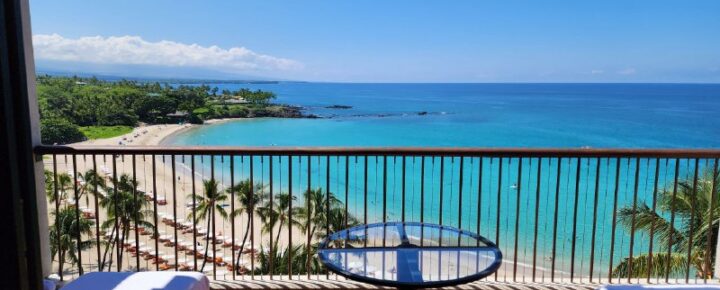In parallel with huge legislative reforms, and legal questions arising, both statewide and on Maui, the vacation rental market in Hawaii is already experiencing a marked downturn in occupancy rates. Mixed messaging from the state did not help matters either. That contrasts starkly with the far more robust performance of Hawaii hotels.
A recent report from the State of Hawaii for March (below) highlights this trend, with vacation rental occupancy notably lower than that of hotels, signaling shifting preferences, increased concerns, and potential repercussions for Hawaii tourism and the economy. Mixed messaging from the state
This downturn comes in the same week as recent legislative actions, including Governor Josh Green signing the bill that empowers counties to regulate or even outright eliminate vacation rentals. Maui has already taken aggressive steps by planning to phase out approximately 7,000 rentals, as detailed in our previous coverage. These developments reflect a broader strategy to repurpose short-term Hawaii vacation rentals to alleviate the state’s acute housing shortage.
Update: The decades-long growth of Hawaii vacation rentals, now rapidly changing, has led to what critics and some commenters here describe as economic exploitation. Speculators have purchased properties for vacation rentals, allegedly squeezing out residents. This is said to have led to increased housing costs and a decrease in available housing for residents. All of this has added significantly more pressure on vacation rentals, even before the legal battles get going.
With this in mind, Governor Green has also now emphasized the need for careful legislative crafting by Hawaii’s counties in order for them to avoid the potential lawsuits and issues of unconstitutionality that are lurking. In doing so, he reaffirmed the complex legal landscape surrounding vacation rental regulation here in Hawaii.
The decline in visitor interest and occupancy is significant for Hawaii vacation rentals.
For a myriad of reasons, statewide, the vacation rental occupancy rate plummeted to just 60% for all of 2023, a sharp decline of 25% compared to 2019. This decline in demand coincides with a 14.5% reduction in short-term rental supply since the pre-pandemic era, reflecting a contracting market.
At the same time, the price of Hawaii vacation rentals surged by 45% in 2023 compared to pre-Covid, with the average daily rate reaching $301 before 18% taxes and multiple fees.
For March 2024, the state DBEDT reported a significant downturn in occupancy rates, reflecting a growing disfavor among visitors for short-term rentals compared to traditional Hawaii hotels. The data for this period shows a pronounced gap between the occupancy levels of vacation rentals and hotels.
Despite a slight rise in supply, demand in March only saw a slight increase of 4.3% over the previous year while remaining 25.9% below March 2019 levels. The statewide vacation rental occupancy rate for March was 57.4%. This occupancy rate marks a decrease of 5.3 percentage points from 2023 and an even more significant drop of 21.2 percentage points compared to 2019. The Average Daily Rate (ADR) for vacation rentals increased to $337, up 3.5% from 2023 and a whopping 57.8% from 2019, indicating widespread higher pricing despite lower occupancy rates.
This occupancy data of 57.4% in March contrasted sharply with Hawaii’s hotel sector, where the occupancy rate was at 74.6% for the same March 2024 period.
The decline in vacation rental performance likely doesn’t reflect even the notion of the regulatory changes that are just starting. Visitor sentiment, however, has already shifted, in part due to increased pricing, inconsistent quality, and other concerns, including questioning the legality of short-term rentals. This aligns with historical data indicating a long-term decline in visitor interest in Hawaii vacation rentals, including on Maui and Kauai.
The legislative imperative to curtail vacation rentals, in itself, reflects a significant policy shift. The state has now granted the counties the explicit authority to phase out Hawaii vacation rentals, which brings the potential for reshaping the visitor accommodation landscape across the islands. The move is supported by entities such as the Hawaii Lodging and Tourism Association (HLTA), which sees it as a means to reduce competition for hotels and potentially stabilize or even increase hotel occupancy and pricing.
Hawaii grapples with these changes, and the economic implications are profound.
The vacation rental sector, once a boon to Hawaii’s tourism economy, faces a precarious and uncertain future. Property owners, local businesses, and service providers who have long depended on the thriving vacation rental market may find themselves navigating new economic realities.
The full impact of these recent changes on Hawaii tourism, local housing, and overall economy remains to be seen. As stakeholders continue to debate this topic and help shape the future of Hawaii vacation rentals, the outcome will have profound and long-lasting implications for Hawaii visitors and residents.
hawaii-vacation-rental-performance-2024-03






I own my condo outright. I have paid the state over $60,000 in GET & TAT. Now times that by how many TVRs are there? Well guess what, I wont rent it out any longer, I won’t sell it either and now the state wont get one more dime of TAT & Get. Hoping all other TVRs do the same. Now who wins! This entire tourist issue was created by your own politicians over the years and this bill was funded by the hotel industry anyway. To think this will make affordable housing is laughable but not a surprise coming from the level of intelligence of commerce from those in office. Good luck in court Green and explaining to those that work in the service industry tied to tourism that no longer have jobs.
We have come to Kauai every single year for decades. Usually for a month or sometimes six weeks. We work hard and save and save to be able to come back. We are terribly sad we are not able to continue. The costs have become extremely heavy to the point of being ridiculous.
We figured out we could take 3 vacations elsewhere that is tropical and beautiful for the same cost as one visit to Kauai.
Kauai is in our hearts and souls. We love the people, we respect the island and wildlife.
We are sad beyond belief.
BOH guys:
I found an interesting article in the Harvard Business review:
hbr.org/2024/02/what-does-banning-short-term-rentals-really-accomplish
Please post if you think appropriate.
Thanks
Thank you for the article. It’s good to see an objective, data based evaluation of the short term rental market.
“Given the large widespread benefits and the limited concentrated costs of short-term rentals, how should cities regulate short-term rentals? By striking a balance, so that travelers and hosts gain without short-term rentals overwhelming entire neighborhoods or significantly reducing the housing units allocated to long-term renters. This can be accomplished with limits — rather than outright bans — on when and where housing units can be rented out to travelers.” That’s a more nuanced and effective position.
I’m confused, if Hawaii’s population is declining, how can there possibly be an acute housing shortage…..doesn’t make any sense!
In 2019 our family of four vacationed for three weeks in Hawaii and spent on average $200-300 per day supporting local businesses over our three week trip. The cost of the same trip in 2024 was 3x as expensive and thus we only stayed for one week, paired down the activities and spent slightly the same amount per day. The sooner the state realizes that tourists wages have not got increased just the same as their local native wages relative to inflationary trends and get back to supporting mom and pop local tourist businesses through better policy the better. Trying to wrap this into big chain hotels by eliminating airbnb and short term rentals will not help. We too will find other places to explore, though Maui will forever be in our heart